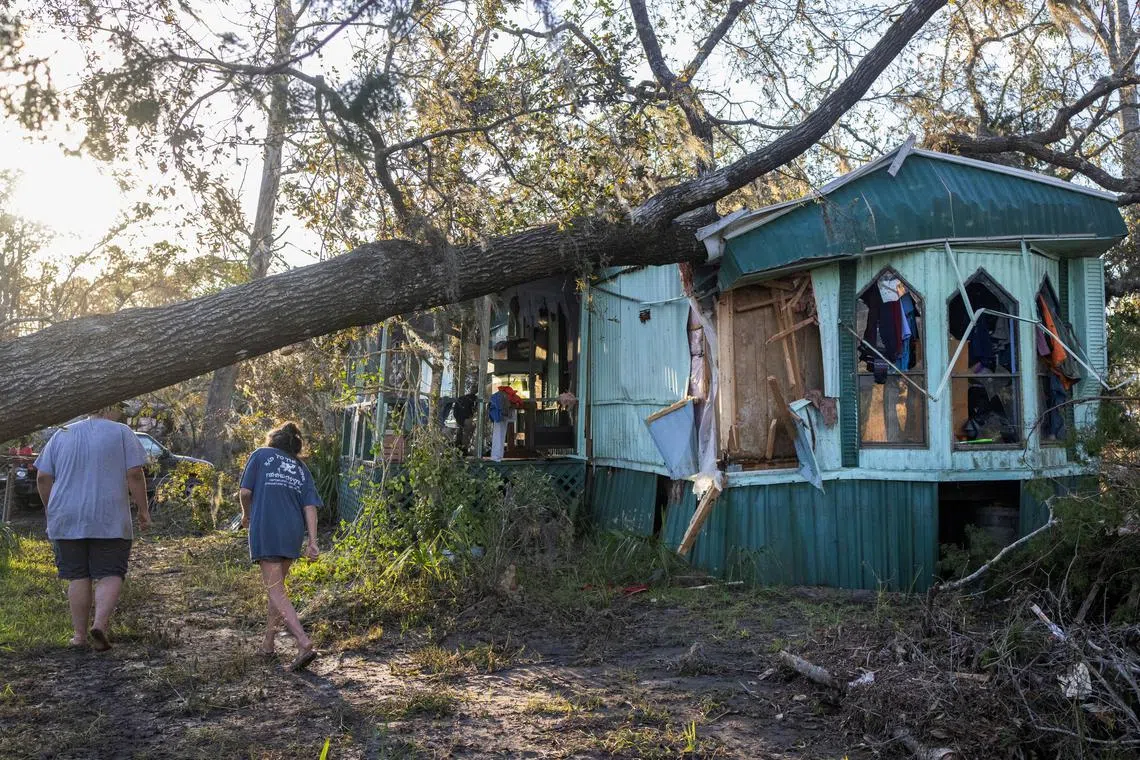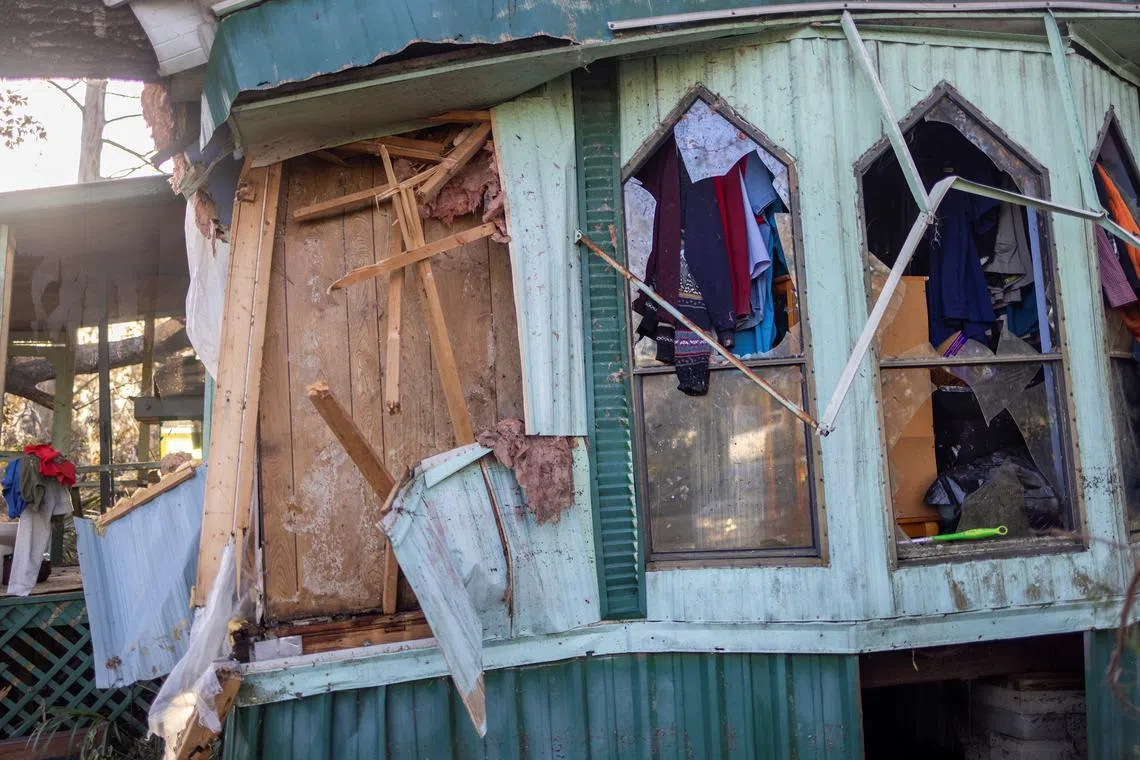US south-east faces daunting task cleaning up from Helene; death toll rises
Sign up now: Get ST's newsletters delivered to your inbox

Helene, downgraded late on Sept 27 to a post-tropical cyclone, continued to produce heavy rains across several states, sparking life-threatening flooding.
PHOTO: REUTERS
Follow topic:
ATLANTA - The authorities across a wide swathe of the south-eastern US faced the daunting task on Sept 28 of cleaning up from Hurricane Helene, one of the most powerful to hit the country, as the death toll continued to rise.
At least 44 deaths were reported in the early hours of Sept 28, and officials feared more bodies would be discovered across several states.
Helene, downgraded late on Sept 27 to a post-tropical cyclone, continued to produce heavy rain across several states, sparking massive flooding that threatened to create dam failures that could inundate entire towns.
In Florida’s Pinellas County near Tampa, Sheriff Bob Gualtieri said he had never seen destruction like that which Helene wrought.
“I would just describe it, having spent the last few hours out there, as a war zone,” Mr Gualtieri told a press conference.
Power had been restored in some areas since night fell over the region on Sept 27, but nearly four million customers were still without electricity across 10 states in the early hours of Sept 28, according to tracker PowerOutage.us, with US meteorologists warning of possible “long-duration” outages.
Scientists say climate change contributes to fuelling stronger, more destructive hurricanes.
Before moving north through Georgia and into Tennessee and the Carolinas, Helene hit Florida’s Big Bend region as a powerful Category 4 hurricane during the night of Sept 26, packing 225kmh winds. It left behind a chaotic landscape of overturned boats in harbours, felled trees, submerged cars and flooded streets.
Police and firefighters carried out thousands of water rescues throughout the affected states on Sept 27.
More evacuations were ordered overnight into Sept 28 as flooding threatened to breach dams in North Carolina and Tennessee.
The National Weather Service (NWS) warned an eastern Tennessee dam was on the verge of failure and urged downstream communities to “move immediately to higher ground”.
Record-breaking river flooding hit several southern states, the NHC said, with massive flooding reported in Asheville, a city in western North Carolina.
“This is one of the worst storms in modern history for parts of western North Carolina,” state Governor Ray Cooper said in a briefing on the night of Sept 27.
In Cedar Key, an island city of 700 people just off Florida’s north-west coast, the full destructive force of the hurricane was on view.
Several pastel-coloured wooden homes were completely destroyed, victims of storm surge and ferocious winds.
“I’ve lived here my whole life, and it breaks my heart to see it,” said Mr Gabe Doty, superintendent of Cedar Key’s water and sewer district. “We’ve not really been able to catch a break around here.”
Meanwhile, more than 50 people were rescued from the roof of a hospital in Unicoi County, Tennessee, about 200km north-east of Knoxville, state officials said, after floodwaters swamped the rural community.
The Unicoi County Emergency Management Agency said on social media that rising waters from the Nolichucky River prevented ambulances and emergency vehicles from evacuating patients and others there. Emergency crews in boats and helicopters were conducting rescues.
Elsewhere in Tennessee, Mr Rob Mathis, the mayor of Cocke County, ordered the evacuation of downtown Newport because of a potential failure at the nearby Walters dam.
In western North Carolina, Rutherford County emergency officials warned residents near the Lake Lure Dam that it might fail, although they said late on Sept 27 that failure did not appear imminent.
In nearby Buncombe County, landslides forced interstates 40 and 26 to close, the county said on X.
Waking to disaster

The authorities across a wide swath of the south-eastern US faced the daunting task on Sept 28 of cleaning up from Hurricane Helene, one of the most powerful to hit the country.
PHOTO: REUTERS
The extent of the damage in Florida began emerging after daybreak on Sept 27.
In coastal Steinhatchee, a storm surge – a wall of seawater pushed ashore by winds – of 2.4m to 3m moved mobile homes, the National Weather Service said on X. In Treasure Island, a barrier island community in Pinellas County, boats were grounded in front yards.
The city of Tampa posted on X that emergency personnel had completed 78 water rescues of residents and that many roads were impassable because of flooding. The Pasco County sheriff’s office rescued more than 65 people.
Officials had pleaded with residents in Helene’s path to heed evacuation orders, with National Hurricane Centre director Michael Brennan describing the storm surge as “unsurvivable”.
Mr Gualtieri, the Pinellas County sheriff, said the conditions prevented first responders from answering several emergency calls. On Sept 27, the county authorities found at least five people dead.
Two others in Florida died, said Governor Ron DeSantis.
Georgia Governor Brian Kemp's office reported 15 storm-related fatalities in that state, while North Carolina Governor Roy Cooper said there had been two deaths there.
At least 19 people died during the storm across South Carolina, the Charleston-based Post and Courier newspaper reported, citing local officials. REUTERS

